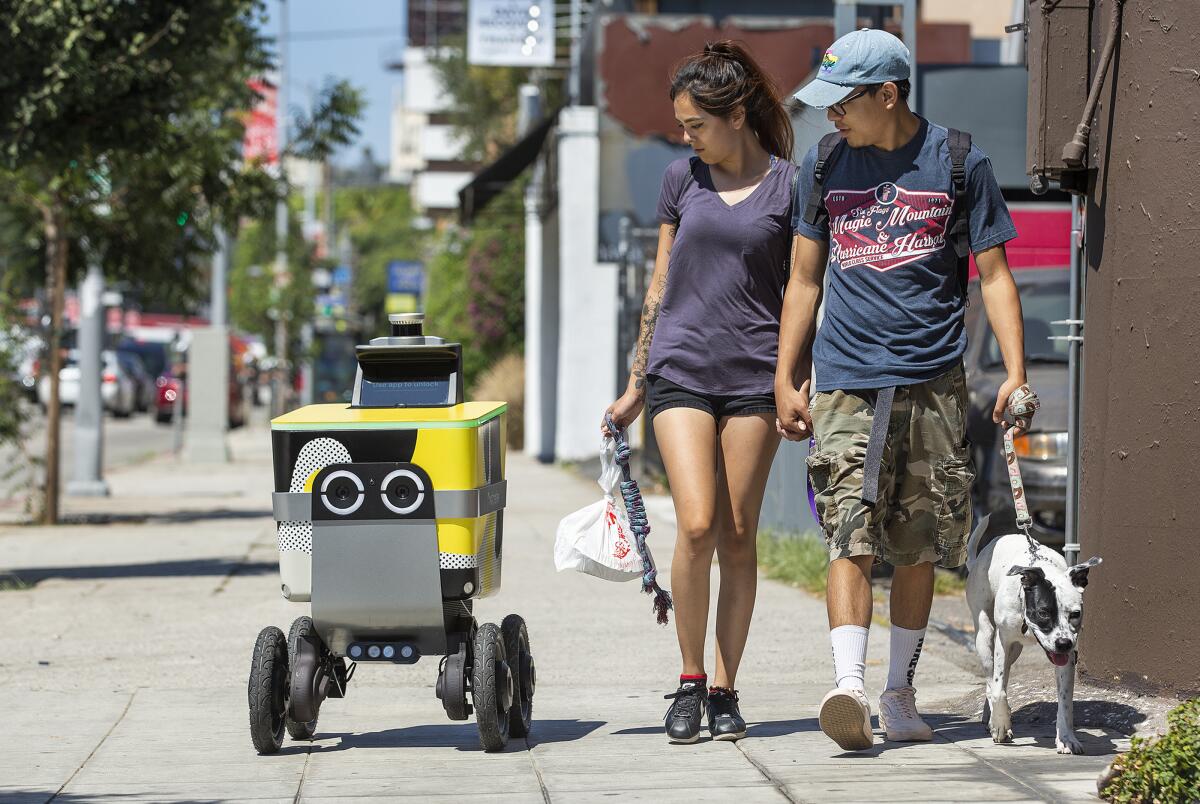Ready for IPO, Postmates needs to win big in L.A. — or else

Bastian Lehmann, the German-born chief executive of delivery app maker Postmates Inc., has taken to wearing a Dodgers cap and a crisp white tee, at least whenever cameras are around.
Lehmann has never lived in Los Angeles. (Postmates is based in San Francisco.) He has been to only a handful of Dodger games.
For the record:
10:15 a.m. Sept. 27, 2019An earlier version of this story inaccurately said DoorDash owns both Seamless and Caviar. DoorDash owns Caviar; Seamless belongs to GrubHub, a competitor.
But his company, which is poised to go public in the coming weeks and is currently valued at $2.4 billion, needs Los Angeles. So Dodgers cap it is.
IPOs are meant to be victory laps for investors and early employees, but at first glance, Postmates heads into this one in a less than ideal position. Among the major services providing on-demand restaurant delivery via smartphone app, it ranks fourth for national market share, and its competitors have significantly more cash to burn. DoorDash, the national leader, has raised $1 billion in 2019 alone. Grubhub, the No. 2, dominates the lucrative New York City market. Uber Eats, which comes in third across the country, has the $55-billion market cap of Uber behind it.
And this year has not been kind to money-losing consumer tech companies making their public market debuts.
First Lyft, then Uber went public in the spring, only to see their stock prices crater once their financials were exposed, showing massive losses and no clear path to black ink. We Co., the parent of WeWork, seemed to disintegrate as soon as its balance sheet — and the self-dealing and self-aggrandizement of its now-ousted founder-CEO, Adam Neumann — saw daylight.
Postmates first filed confidential paperwork with the SEC back in February, but reports that it has entertained buyout offers from DoorDash and Uber this year suggest that the company is aware of the difficulties it faces.
In mid-September, Postmates raised a final round of $225 million from a private equity firm, a move that could indicate a desire to pump up its valuation before going public, or a sign it was running out of cash. In 2018, according to Forbes, the company failed to break a profit on $400 million in revenue. At the same time, new California regulations that threaten to upend the company’s entire business model were signed into law.
But throughout it all, the company has held on to Greater Los Angeles, a crown jewel market of 10 million consumers, many of them flush with disposable income and reluctant to leave their homes in search of food, despite the nice weather. According to data from credit card spending analysis firm Second Measure, Postmates currently commands 40% of the L.A. market, after years of fending off attacks on its customer base and driver corps from DoorDash and Uber Eats.
L.A. is the proving ground for Postmates’ pitch to investors that it’s not just another money-burning machine. But it landed in the city only after trying five others first: San Francisco, Seattle, New York, Washington and Chicago.
“We just weren’t sure if it was a market that lends itself to delivery,” Lehmann said. “It’s rather spread out, almost like many cities in one — I have friends that live in Santa Monica and they have a very good friend that lives in Silver Lake, and they see each other less than they both see me, and I live in San Francisco.”
But after launching its service here in 2014, the company found the fusion of city and suburb made for the perfect delivery landscape. Built for cars but densely packed, full of both restaurants and people who would rather just eat at home — the inefficiencies of daily life in Southern California proved ideal for the economics of delivery.
And the celebrities helped. Unprompted, boldface names such as Ava DuVernay and Anna Kendrick started talking about Postmates on social media. Jimmy Kimmel claimed to have invented it on his show, in a 30-second riff on how useful the app is with “Modern Family” actor Ariel Winter. Post Malone even name-dropped Postmates in a song.
“Our entire marketing strategy is around influencers who are real customers,” Lehmann said. “Chance the Rapper, Kylie Jenner — these are people who live in L.A. and use Postmates all the time.”
To capitalize on the free publicity, the company itemizes celebrities’ delivery expenditures in a blog series called the Receipt.
Today, L.A. has the company’s highest density of regular subscribers, the highest number of exclusive merchants — restaurants that deliver only with Postmates — and some of the fastest deliveries happening in the country, Lehmann said.
Efficiency metrics such as those are the difference between success and failure for a logistics company. To supercharge that local network effect, earlier this year the company introduced Postmates Party, which gives users free delivery if they order from the same restaurant as a nearby user within a certain time window, allowing drivers to stack orders without racking up extra delivery miles. After launching in March, it grew to make up 12% of all orders on the app by midsummer. (Uber and Lyft offer similar incentives to passengers to combine their trips through their shared-ride service tiers, Uber Pool and Shared Lyft.)
By the end of the year, Postmates plans to have a 100-engineer satellite office in the city, its largest outside of San Francisco. The company also has a deal with the Dodgers for in-stadium delivery.
But Los Angeles isn’t all sunshine for Postmates.
California recently signed a bill into law, Assembly Bill 5, that was written to fundamentally change the business model of “gig economy” companies such as Uber, Lyft and Postmates.
Since their founding, these companies have claimed that they don’t employ the people who sign up to pick up passengers or deliver food on their apps, but only provide a platform for independent drivers and couriers to connect with interested passengers or people who want food delivered to their doorstep. That allowed the companies to classify the people working on their platforms as independent contractors, responsible for their own payroll taxes and not entitled to the rights — regular breaks, paid sick days, compensation for mileage — of typical employees.
AB 5 threatens to upend that system. As it stands today, most of the 450,000 gig workers in California may have a claim to be reclassified as employees — regardless of the number of hours they work each week.
Gov. Gavin Newsom has said that he remains open to negotiating with the major tech companies to create a third category of work for ride-hailing and delivery drivers, but nothing concrete has emerged from those talks. As a backstop, Uber, Lyft and DoorDash have each pledged to pour $30 million into a ballot measure that would exempt gig workers from the law.
Dan Ives, an analyst at Wedbush specializing in consumer tech companies, said it was hard to overstate the bill’s potential effect. “It’s a dark cloud across the economy,” he said, pointing to the stock prices of Uber and Lyft, which have lost 25% and 30% of their value in the last two months. “Investors are white knuckles when it comes to AB 5.”
Postmates’ reliance on California customers makes it particularly vulnerable to the new law, but the company’s official line is upbeat.
“Postmates follows California law, as it did before and after the Dynamex decision, and will exhaustively work alongside the Legislature, workers, and residents of the state to recognize AB5 as a comma, not a period, in the story of how we invest in the future of the American worker,” the company said in a statement.
Lehmann, for his part, said that he supported the creation of a “multimillion-dollar benefit fund” for gig workers, to which every company in the gig sector would contribute to support healthcare, retirement and workers’ comp benefits for drivers. This is in line with the stated goals of the companies backing the ballot measure, who argue that sectoral bargaining — allowing one union to strike a deal for all gig workers, with industry approval — would be a better system than reclassifying drivers as full employees.
But Postmates has another insurance policy in the works. In the coming months, the company says, Angelenos ordering off the app might be met at the door by Serve, a delivery robot that Lehmann says the company has been developing for more than two years.
Besides requiring no breaks, healthcare benefits or legal classification as anything other than equipment, a robot delivery fleet is a necessary step to making Lehmann’s original vision for Postmates a reality, he said.
“We have this dream that our delivery infrastructure should be available to every merchant and customer in a geographic region at as close to zero cost as possible,” Lehmann said. “Imagine if it cost zero to deliver a good in L.A. — if that’s the case, then suddenly a lot of local businesses, even ones that have a different margin structure than prepared food, could have a leg up.”
Remove the human element — and the cost of labor — and suddenly it becomes just as economical to order lightbulbs from the hardware store down the block as it is to order them through Amazon’s fine-tuned supply chain.
On a recent afternoon in Hollywood, servers from Fat Sal’s practiced putting orders in the robot’s cooler-like body, responding to prompts displayed on its touch screen.
There was just one snag: The robot’s networking equipment was down, so it could move around only when a Postmates engineer plugged in a controller and drove it around manually, a few paces behind. As it trundled down the sidewalk, a pair of teens doubled up on an electric scooter almost slammed into the machine before zigging out of the way.
Robots could one day provide a long-term solution to the problem of delivery economics. For now, they are just one more thing Postmates will need to figure out.
More to Read
Inside the business of entertainment
The Wide Shot brings you news, analysis and insights on everything from streaming wars to production — and what it all means for the future.
You may occasionally receive promotional content from the Los Angeles Times.











